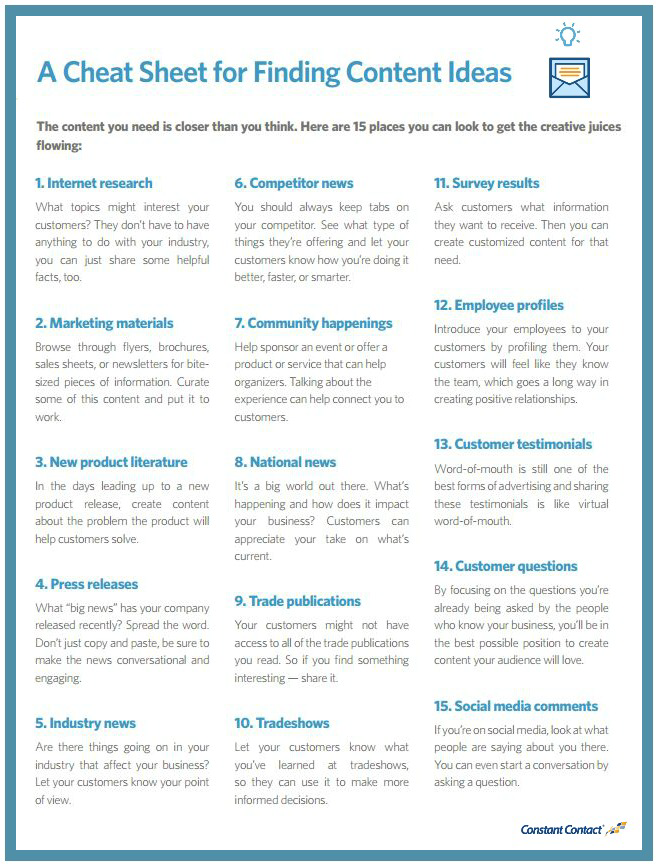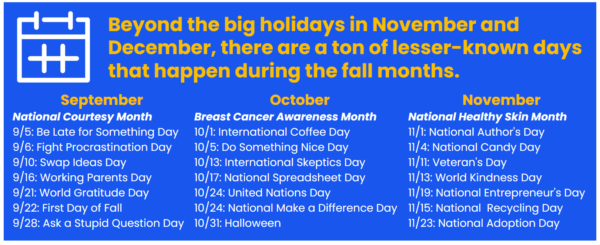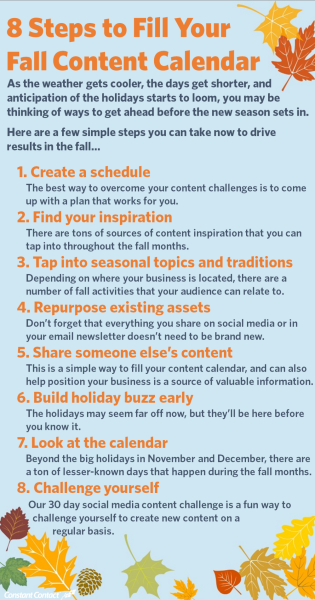As the weather gets cooler, the days get shorter, and anticipation of the holidays starts to loom, you may be thinking of ways to get ahead before the new season sets in.
When it comes to your marketing content, there are simple steps you can take now to drive results in the fall and set yourself up for success in the months ahead.
And the best part is, these steps won’t get in the way of all the important work you’re already involved in.
Ready to fill your fall content calendar? Here are eight steps you can take:
1. Create a schedule
The best way to overcome your content challenges is to come up with a plan that works for you.
Follow through with your social media plans this fall by creating a content calendar and sticking with it. Don’t overestimate the amount of time and energy you will be able to dedicate to your content schedule. Be realistic.
You can accomplish a lot by simply being consistent. Having a schedule is only half the battle; following through with it is something completely different.
Here are two helpful resources to get the ball rolling:
- How to Create a Social Media Posting Schedule
- 5 Tips to Help You Stick to Your Social Media Posting Schedule
2. Find your inspiration
If you’re not excited about the content you’re creating, it’s unlikely that the people seeing it will be inspired to take action.
The good news is that there are tons of sources of content inspiration that you can tap into throughout the fall months.
Check out the cheat sheet below for tons of new content ideas:

3. Tap into seasonal topics and traditions
Depending on where your business is located, there are a number of fall activities that your audience can relate to.
Look for opportunities to use these seasonal topics and traditions to engage your audience in a timely and relevant way. This can humanize your business and help customers connect with you in a whole new way.
Here are a few ideas to get you started:
- Fall activities. The new season means new colors, activities, weather, and foods. Create content inspired by things that make this season special to you.
- Football. Although it’s been put on hold this year, that doesn’t mean you have to lose your spirit. For generations of American households, fall weekends have centered around high school, college, or professional football games. To keep that spirit alive, share your best tailgating recipes or ‘touchdown-worthy’ tip for making the most of your weekend.
- Shopping. A lot of shopping takes place in the fall — from back-to-school shopping, to shopping for Halloween candy and costumes, to the biggest shopping days for the holidays. Offer your fans and followers content that helps with fall budgeting, smart ways to shop, or ways to save money with DIY projects.
4. Repurpose existing assets
Don’t forget that everything you share on social media or in your email newsletter doesn’t need to be brand new.
By repurposing the great content you already have and delivering it in new ways, you can get more out of the content you’ve already created. Not only will you save time, but it can help create brand consistency, build authority, and raise awareness in a whole new way.
Here’s a tip on how to create engaging content.
5. Share someone else’s content
Chances are you already have places you look to find entertaining and informative content online.
When you find something that you think your audience will also be interested in, don’t be afraid to share it! This is a simple way to fill your content calendar, and can also help position your business as a source of valuable information.
Here are some helpful tips for sharing other people’s content.
6. Build holiday buzz early
The holidays may seem far off now, but they’ll be here before you know it.
With your social media calendar planned in advance and ready to execute, you can scratch one of your biggest marketing responsibilities off your to-do list and focus on your other holiday marketing plans.
Aside from the usual rush around the big traditional holidays, don’t forget the big shopping days that kick off the season:
- Black Friday – November 27th
- Small Business Saturday – November 28th
- Cyber Monday – November 30th
Talking about Black Friday or Small Business Saturday — rather than specific holidays — in September or October is a great way to start getting your customers ready for the season.
7. Look at the calendar
Beyond the big holidays in November and December, there are a ton of lesser-known days that happen during the fall months. Here are some you should be aware of:

To explore other holidays that may be more relevant to your business, check out Days of the Year or Holiday Insights — two of my favorite resources.
8. Challenge yourself
Okay, you’ve outlined a schedule and found the ideas and inspiration you need to fill your content calendar, now it’s time to challenge yourself to make sure you actually see things through.
Need help? Try our 30-day social media content challenge. This is a fun way to challenge yourself to create new content on a regular basis. Or set up your own challenge to make sure you see things through.
Looking to streamline your online marketing ever further? Check out our free guide to online marketing, The Download!
Ready to get started?
Don’t wait to start planning for the months ahead. Before you know it, the seasons will be changing again and the holidays will be here!
With these 8 tips in mind, filling up your fall content will be a breeze!
Put these tips to work today. Log in to your Constant Contact account to get started!
Editor’s Note: Originally posted in 2014, this article has been updated for relevance and accuracy.
If you’re using Facebook for your business, you’ve probably asked the question — are Facebook Ads really worth the time and money?
It’s a fair question to ask.
After all, you probably signed up for Facebook with expectations that it was strictly a free platform.
And without an extensive marketing budget, it’s understandable that you wouldn’t want to risk your valuable marketing dollars on something you’re still unsure of.
But here’s the thing — paying to promote your content is one of the best ways to reach the right audience on Facebook.
This is especially true if you own a small business that primarily serves a local clientele.
With Facebook’s ad targeting features, you can easily target your content to Facebook users living in and around your city or town.
You can also use Facebook’s Custom Audiences tool to target people who are already on your email list. Or Facebook’s Lookalike Audiences feature to target people who have similar interests as the people on your email list.
Whether you’re looking to get more visibility for a special announcement or want a better way to reach potential customers on Facebook — Facebook Ads can help.
Here are four examples of Facebook ads that drive results:
1. Raise awareness in your community
Sometimes, your goal on Facebook will simply be to generate awareness. This is especially true if you’re a new business or you recently underwent a major change.
Take this example from Bridge Cape Ann:
The ad ran for one week, with a set budget of $15 per day.
According to Jon Cooney, founder of Bridge Cape Ann, the video reached 16,000 people and generated more than 2,400 clicks. Most importantly, it helped get the word out about Bridge Cape Ann.
“Promoting our video on Facebook definitely generated a lot of good word-of-mouth in our community and helped introduce us to a number of new clients,” Jon explains. “It helped kick off our relaunch in a major way.”
If you don’t have a video that captures your business, look to share another piece of content that illustrates the great work your team is doing. This could be a post from your blog, or could also be a recent email announcement.
2. Promote a local event
Posting about your event on Facebook has always been a great way to promote a special occasion for your business.
The only problem is that with changes to Facebook’s News Feed algorithm, the number of people who see your posts about the event can be limited.
To solve this problem, take a look at a recent post you’ve done about an upcoming event. Is there one that generated higher than average engagement (likes, comments, or shares)?
You don’t always have to create something new when promoting a post. If a post is already doing well, it’s likely it will do well when you pay to put it in front of a larger audience.
Because you’re paying to promote your event, it’s important to have an event landing page. Don’t rely on someone seeing your post and remembering to show up. Include a link to an event landing page and give them the option to register in advance.
3. Attract local customers with a great offer
For a lot of small businesses, email marketing is one of the most powerful channels for promoting an upcoming sale or special offer.
You create a professional-looking email, send it out to your list of contacts, and people either click through to redeem the offer or print out your email and come into your store or office.
But what if you could extend the reach of that email beyond the inbox and promote your offer to people who haven’t already signed up to your email list?
With Facebook’s custom audience feature, you can easily upload your list and Facebook will match those email addresses to find contacts that are already on the site. You can choose to promote your offer to this audience to improve your chances of being seen by people who already know your business.
Or, you can use your list to create a lookalike audience. With this feature, Facebook uses the list of contacts that you upload to generate a list of people who live in your targeted area, that have similar interests as the people on your list.
This is a great opportunity to not only retarget the people who are on your list and may not have acted on the offer, and also get your business in front of a whole new audience.
4. Grow your audience beyond Facebook
Paying to promote your content on Facebook can help build your social media audience, and also presents a valuable opportunity to grow your email list.
You can use Facebook Lead Ads to target new email subscribers by location or interests. These ads are easy to create and point Facebook users to a sign-up form that’s pre-filled with contact information that they’ve publicly shared on Facebook. Once your new subscribers fill out the form, their information will be automatically pulled into your Constant Contact account where you can start engaging with them.
Choose one of these ideas to see how Facebook Ads can work for you.
Pick a goal for your ad. Maybe you just want more visibility or Facebook fans or maybe you’ll want to attract a certain number of new customers.
Based on your goal, make sure to choose a budget that you’re comfortable with and use Facebook’s built-in targeting features to reach the right audience.
Finally, make sure to track your results. Did you add new fans or see a spike in engagement? If you’re promoting an event, did you see better attendance numbers? Or if you’re promoting an offer, did you see more foot traffic during and after the ad was running?
This information can help you make decisions about whether paying to promote your content on Facebook is right for your business, and will show you what you can do differently to improve your results.
Have additional questions?
You can find more Facebook tips on our Facebook 101 page.
By now, you may have heard about Facebook’s decision to prohibit the practice of like-gating on its site.
If you haven’t, here’s what you need to know:
On August 7, Facebook announced an update to its Platform Policy to prohibit the practice of like-gating — or requiring someone to like your Facebook Page in order to receive an incentive.
Facebook’s decision to ban like-gating is based on a simple but an important idea — “to ensure quality connections and help businesses reach the people who matter to them.”
Facebook has given businesses 90 days (until November 5, 2014) to comply with this policy change.
Why is this important?
If you’ve been on Facebook for a while, you won’t be surprised to hear that Facebook has undergone a lot of changes in recent years.
As Facebook grows, the social media company has come to understand how important ensuring quality connections between users — and the businesses and organizations they follow — is to their own long-term success.
One of the ways that they have done that is with the News Feed algorithm, which controls the content users see in their feed. Facebook uses a series of factors to determine which content users will find interesting, and as a result, only show your content to a portion of your Facebook audience.
The removal of like-gating takes that a step further.
Facebook believes that if people like your page only to receive an incentive, then they may not be engaged or interested in what you’re sharing after the promotion is over. Instead, Facebook wants businesses to encourage customers and potential customers to like their page without requiring them to do so.
They believe that this will allow you to build a fan base that is more engaged, and as a result, more likely to interact with your business and act on the content you share on Facebook.
How does the change impact your business?
Rather than encouraging people to Like your page, you should look for opportunities to move relationships beyond Facebook and onto your email list.
This allows you to take ownership of your contacts. It also keeps you from having to worry about further Facebook changes that make it difficult to reach your audience.
So while Like-gating is no longer an option, you can still require users take some specific action before redeeming a coupon or entering a Facebook contest, without forcing them to like your Page.
There are a number of benefits of using an action gate on Facebook.
One of the biggest benefits is that you’re able to engage your current fans beyond the traditional like, comment, or share. This means that you’ll not only have the opportunity to grow your email list, but you’ll also be able to strengthen relationships with the people who like your page and even turn them into new or repeat customers with an exclusive offer.
In addition, action gates allow you to think differently about the campaigns you decide to run. While like-gated offers limit your ability to extend your reach beyond Facebook, action gates allow you to easily promote your offer across different channels and drive people to an offer, hosted on your Facebook Page.
This is a great opportunity to encourage your connections on different social channels to like your Page, without requiring them to do so. Even if they don’t choose to like your Page at first, you can still use email to continue the conversation and potentially include links back to your page in future messages.
Here are a few examples of action-gated campaigns you can run:
- Capture leads on Facebook with an exclusive download: While a like gate only allowed you to add new fans, an action gate allows you to capture new leads on Facebook and nurture them with email. One of the best ways to capture a new lead on Facebook is to offer an exclusive download with helpful information. After adding a new contact to your email list, you can easily send a follow up email with more information, or even create an autoresponder email series to help introduce them to your business.
- Turn current fans into paying customers with a special offer: Because you’re not just focused on adding new fans, an action gate is a perfect way to reward current fans with an exclusive offer. We all know how difficult it can be to turn all those likes, comments, and shares into actual business results. Think of a special discount your fans would love and promote it to your fan base. After providing their email address, they will receive a coupon in their inbox.
- Run a sweepstakes and keep the conversation going: With an action gate, you can run a sweepstakes on your Facebook Page that people can enter by providing their email address. When the winner is chosen, you can contact them via email and even reach out to non-winners after the contest is over. You can create a separate list within Constant Contact, and send targeted emails to introduce new subscribers to your business. You can also reward non-winners with a separate offer, and encourage them to visit your store, restaurant, or office.
Ready to get started?
There are a number of ways you can use action-gating to drive real results on your Facebook Page.
Start planning your action-gated campaign today.
Have additional questions about Facebook’s latest change? Post them in the comments below. Or visit our Facebook 101 page for more Facebook marketing tips.

